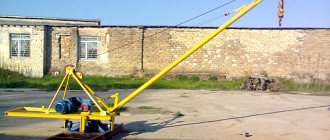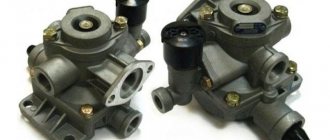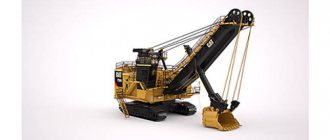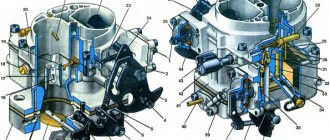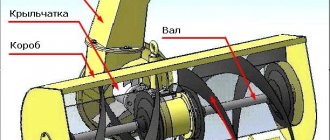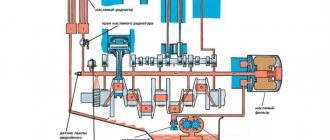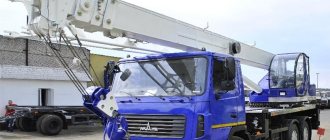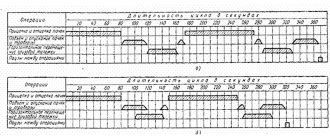Carrying out construction, installation, repair and loading and unloading work at construction sites of buildings and structures, warehouses, bases of trading enterprises and landfills is impossible without the use of specialized lifting equipment.
The Pioneer jib crane is a widely used model for general industrial use. The device easily supplies building and roofing materials, roofing felt, insulation, and tools to the roof, and moves machines and elements of installation structures. The mechanism can be operated both at low temperatures down to -40°C and up to +40°C.
Design and principle of operation
The crane is a collapsible structure, installed at different construction sites with a permissible slope of no more than 3°. The mechanism is manufactured in several modifications in accordance with GOST 1451-77.
The main assemblies of the lift:
- rotating frame with drive;
- running frame;
- arrow;
- hook suspension;
- final stop mechanism;
- screed;
- cargo rope;
- counterweight;
- load;
- safety rope;
- travel switch;
- winch;
- electrical equipment.
The running frame can be stationary or wheeled.
The boom is made in a collapsible design or in one piece. The thickness of the arrow is no more than 10.2-13.3 cm. The length does not exceed 3.5 m.
Rope thickness - 0.69-0.78 cm.
The minimum counterweight weight is 750 kg.
Depending on the load capacity, the crane can be rotated in 2 ways:
- manual;
- mechanical.
The winch is driven by an electric drive with a power of 4-4.75 kW, operating from a network with a voltage of 380 V. The mechanism raises and lowers the load to a height of 4.5-6.2 m with a boom extension of 250 cm at a speed of 8.4-16 .8 m/s. The crane platform rotates around its own axis. In some cases, a special platform cradle is installed.
The control process is carried out by the operator using a remote push-button remote control.
Pioneer lifting mechanisms are divided into 3 types based on maximum load:
- 0.5 t;
- 0.75 t;
- 1 t.
All other characteristics depend on the carrying capacity.
Installation and operation of crane mechanisms
First, a support frame is installed on the prepared base, into the central hole of which a rotary axis is inserted. Before this, a thorough inspection of the bearings is carried out, if necessary, their internal surfaces are cleaned of dirt and lubricated.
A rotating frame is installed on the axle, which is fixed to it using a wedge-shaped bushing. Counterweights are installed. The horizontal surface of the frame is verified using a plumb line (preferably a laser): the permissible non-perpendicularity should not exceed 35...50% of the gaps existing between the axle and the inner surface of the bearings.
Next, using screw ties, the load boom is installed. For collapsible options, the arrow for testing functionality is set to the maximum permissible length. Screeds allow you to compensate for the slight slope of the site where the Pioneer crane is located.
After checking the correct installation of the boom, the lifting mechanism is installed, the power supply to the winch drive is connected, and the operation of the crane stop is checked: first, during idle movement of the boom, and then in the mode of lifting and lowering a load with a maximum weight.
The final stage of preparing the crane for operation is the installation of limit and limit switches. The limit switch is a load lifting height limiter and is attached to the boom. The limit switch controls the electric motor for winding the rope onto the drum and prevents the hook from falling off the suspension.
The platform for a crane with a lifting capacity of 500 kg is rotated manually, while the ease of its movement is controlled. For other modifications, rotation of the platform begins by pressing the corresponding button on the control panel.
For safety reasons, it is prohibited to carry out all adjustment and basic lifting operations while the crane is moving on wheels.
Pioneer-500
The Pioneer-500 crane is a device for lifting loads up to 500 kg, which is installed both on the roof or ceiling and on the ground. When carrying out work on the roof, the maximum lifting height can reach 50 m, at ground level - up to 4.5 m. To repair flat roofing surfaces, the mechanism is lifted, installed and connected to an electrical network with a voltage of 220 V, 50 Hz via a flexible cable. For low-level work there is the possibility of attaching to the ground zero point.
The load is gradually lifted at a speed of 16.8 m/min, the platform rotates 360° with a rotating boom, moving the material to the desired location. The turning mechanism is manual, while the process is controlled, the lifting mechanism is electric.
The length of the solid boom for Pioneer-500 is 5200 mm, diameter - 102 mm. The dismountable device consists of 2 parts, each 2700 mm long, connected by bolts.
The chassis with a rotating frame has the following transport dimensions:
- length - 2450 mm;
- width - 1770 mm;
- height - 1325 mm.
Dimensional and weight characteristics of the crane:
- length - 4200 mm;
- width - 1700 mm;
- height - 5400 mm;
- weight without counterweight - 395 kg;
- total weight - 830 kg.
The mini crane can be easily dismantled, disassembled, moved manually to another place, assembled and re-installed.
Jib crane Pioneer
Jib crane Pioneer
designed for lifting various loads weighing up to 500 kg during the construction and repair of buildings and structures. The most popular and widespread are Pioneer cranes, as they have a high degree of productivity and lifting capacity, moreover, they are particularly reliable.
Pioneer cranes will become your indispensable assistants if you are planning to construct a building, especially a building with a small number of floors. brings to your attention a wide selection of Pioneer cranes, the lifting capacity of which varies from 500 to 1000 kg. We offer Pioneer crane rental.
Pioneer adjustable cranes are used for moving and lifting loads during the construction of residential buildings, shops, entertainment complexes, and during repair or finishing work. Pioneer adjustable cranes can be installed both on the ground and on the floors of buildings.
Features of the Pioneer jib crane:
- permissible wind speed: during operation - 14 m/s, for non-operating condition - 33 m/s (operation in IV wind regions according to GOST 1451-77) - climatic modification "U" category I according to GOST 15150-69 (at ambient temperature air from -40°С to +40°С). — supplied without counterweights.
Pioneer-750
The Pioneer-750 crane has technical indicators similar to the 500th model.
Module features:
- the mass of transported cargo is increased to 750 kg;
- lifting speed - 8.4 m/min;
- moving height - 45 m;
- manual rotation - using a special lever;
- load lifting mechanism - AIR100L4EU3 electric motor with a rated power of 4 kW and a rotation speed of 1410 rpm on 3-phase alternating current;
- control is carried out by a 220 V remote control;
- most units are made stationary, the booms are non-removable with a reach of 4.5 m;
- dimensions - 4.2x2.0x5.4 m;
- transport width - 2.18 m;
- transport length - 2.67 m;
- height - 1.35 m;
- weight - 1355 kg.
Pioneer-1000
The Pioneer-1000 jib crane is an advanced multifunctional equipment with a lifting capacity of 1000 kg. The turning and lifting mechanisms are powered by a 380 V electrical network and a driving power of 4.75 kW, making operation quick and easy.
The arrow is produced in 3 versions:
- with a reach of 2.5 m;
- 3m;
- 4 m.
As the length increases, the load capacity and lifting height decrease:
- the boom, designed for a reach of 2 m, moves loads weighing up to 1 ton to a height of 6.2 m;
- at 3 m - up to 0.8 t at a height of 6 m;
- at 4 m - up to 500 kg at 5.3 m;
- for ground mounting - 6 m.
Fixation is done using ties.
Console units are available in 2 versions:
- adjustable;
- mobile on wheels.
On the rotating platform of a stationary lift, special stops are installed that regulate the angle of inclination and protect against tilting.
In a mobile crane, manufacturers construct rails from channels along which movement occurs.
The working speed reaches 11.8 m/min.
In comparison with the Pioneer-500, in which counterweights are hung, in the tonnage counterweights in the amount of 15 pieces of 48 kg each are located in a specially equipped box.
Technical characteristics of KP-1000:
- overall dimensions when assembled - 6100x2140x6500 mm;
- weight without counterweights - 1070 kg;
- total weight - 1820 kg;
- chassis with a rotating frame - 2850x2130x1600 mm;
- boom - 6.45 m.
Pioneer-2000
The Pioneer-2000 crane is an improved version of the KP-1000 lift. After upgrading the model, the liftable load can reach 2 tons. This module is manufactured by the manufacturer to special order and is in demand in the construction of facade structures, when installing windows and sandwich panels.
Features of the 2-ton truck:
- equipped with electromagnetic hydraulic brake;
- electric drive for boom rotation;
- gearbox, power unit and winch with a 4-fold safety margin.
Taking into account the console reach, the maximum lifting capacity with double reeving of the rope is:
- with a reach of 4.6 m - 1500 kg;
- 4.4 m - 1700 kg;
- 4.1 m - 2000 kg.
Maximum lifting height of the hook mechanism:
- at reach 4.6 m - 4.3 m;
- 4.3 m - 4.5 m;
- 4.1 m - 4.65 m.
The maximum depth of lowering the hook is 100 m with a double safety margin of the rope.
Unit operating speed:
- with single reeving - 5.6 m/min;
- at double speed - 11.3 m/min.
The rotating part moves 360° around the axis. The turning radius reaches 3 m.
Structural weight - 1.5 tons.
Advantages and disadvantages
The crane is characterized by high mobility, productivity and lifting capacity.
Its main qualities:
- fast transportation to the place of operation;
- accessible assembly;
- Possibility of installation anywhere - on the roof, ground, floors of objects under construction and in pits.
Before the process, pits are not made and anchors are not used.
The Pioneer lift has low energy consumption, low cost, and is not registered with Rostechnadzor. Persons without special qualifications are allowed to operate. Maintenance costs are minimal.
The disadvantages of modules are:
- the load that is suspended from the crane does not always create safe working conditions;
- The maximum weight that the crane can lift ranges from 500 to 1000 kg, depending on the design.
Pioneer type lift
This unit is lightweight and highly mobile. It assembles and disassembles simply and quickly. It can even be brought to the site in a Gazelle, the work done, and then disassembled and taken away. Moreover, it is quite possible to install the crane on the ground, in a pit, on the roof, as well as on building floors.
Pioneer lifts are made by many enterprises specializing in the production of all kinds of lifting equipment. We can mention the domestic one, Impulse LLC from Kirov, PKF Chelny Crane Company LLC.
There are three main modifications of the crane, the lifting capacity of which can be, respectively, 0.5, 0.75 and 1 ton (this is the maximum). The boom can be solid or collapsible, and the supporting frame, which serves as the base of the unit, can be equipped with wheels or have a stationary design.
Application
This jib crane is capable of moving any objects, working intensively in heat of forty degrees and in frosts down to minus forty. It will easily deliver building materials, installation structures, currently needed equipment, tools and inventory to the roof, as well as to any of the floors.
During roofing work, a unit equipped with a convenient rotating boom will help to quickly supply the required volume of mastic, rolled roofing or insulating material to the roof.
At manufacturing enterprises, the Pioneer crane is often used for carrying out repair work, as well as for quickly loading and unloading any materials, machines, and metal structures.
Photo of Pioneer type lift
The Pioneer type lift is used by trade enterprises, as well as wholesale warehouses. The lift will help to quickly ship heavy rolls of linoleum, pallets with ceramic tiles, and various lumber to the buyer.
Advantages and disadvantages
Advantages:
- Simple and extremely reliable design, ease of use.
- The speed of assembly and disassembly is no more than half an hour.
- High mobility, which allows the crane to be used even at distant sites.
- There is no need to register the lift with Rostekhnadzor.
- There is no need to make a pit before work, and no anchors are required during installation.
- Low cost, low energy consumption.
The boom's 360-degree rotation makes lifting and lowering loads easy.
Flaws:
- Flexibly suspended cargo does not always create comfortable and safe conditions.
- The maximum weight that the crane can lift is from 500 to 1000 kilograms (depending on the modification).
Device
The design of this collapsible mechanism is extremely simple. The crane consists of the following elements:
- The main supporting frame (dismountable, bolted, can stand on wheels), on which the second frame is mounted - a rotating one.
- Safety guy ropes, cargo rope, counterweight, electric drive.
- A rotating boom (which can be solid or collapsible, bolted), equipped with a jib.
- The final stop mechanism (which is located at the end of the boom), the limit switch (it is installed on the lifting mechanism).
Scheme of Piner type lifts
